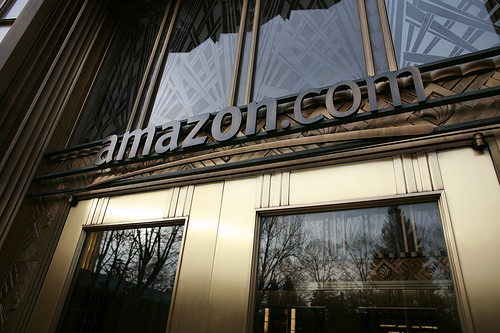Last week I asked what happens when Amazon acquires the same massive negotiating power as the major chain bookstores? But it turns out we may already know the answer.
I just took a closer look at Boston Review‘s 4,500-word article about “Books after Amazon.” It’s got insider interviews, honest statistics, and the real details of a war that’s been going on for decades. It begins with estimates that 75% of America’s online book purchases now happen through Amazon.com — but then reports that for some publishers, Amazon is actually responsible for more than half of all their sales. “Amazon is indisputably the king of books,” the article notes, before citing an independent book publisher asking a very important question: “what kind of king they’re going to be…â€
Kindle owners may be the ones most affected by Amazon’s success — and this article apparently reveals two of Amazon’s dirtiest secrets. “Most customers aren’t aware that the personalized book recommendations they receive are a result of paid promotions, not just purchase-derived data.” And behind-the-scenes, while you’re watching Amazon.com — Amazon’s price tags are also watching you! “Individual customers may get different discounts on the same book depending on their purchase history…”
But there’s also a fascinating discussion about how the prices of books are set. As Amazon grew, it pushed up the chain bookstores’ standard discount to 52–55 percent, “with some as high as 60 percent.” This sounds like a good thing, but there may also be a dark side. The article cites a 2004 article in Publisher’s Weekly that accused Amazon of demanding high discounts from book publishers with the threat of, among other things, making their books less likely to appear in customer searches.
Two publishers even reported that their books did, in fact, disappear altogether from Amazon.com, simply because they’d refused to offer extra discounts when Amazon sold the books! One publisher actually remembers that when he’d told Amazon he couldn’t afford to participate, Amazon’s employees told him he “couldn’t afford not to.†The second publisher’s books eventually returned without agreeing to the discounts — after he threatened to contact The New York Times. “Nonetheless, cases of disappearance continue,” Boston Review reports.
In some cases, a book’s “Buy” button apparently disappears from its web pages at Amazon.com! “In 2008 two huge British publishers — Bloomsbury and Hachette — had their buttons pulled,” the article notes. “That same year, Amazon also removed buy buttons from any print-on-demand publisher that didn’t use Amazon’s on demand printer…a move that led to an antitrust lawsuit in which Amazon agreed to pay a settlement to a competitor, though it admitted no wrongdoing.” And the article also cites an incident last year where Amazon’s ranking system stopped including “hundreds of gay- and lesbian-themed books”.
But the article finally works its way around to the million-dollar question: how is Amazon setting the prices of ebooks? Amazon initially demanded that all publishers price their books at $9.99 — without
consulting them first, choosing simply to “absorb the loss, paying publishers for the price of the equivalent printed book in order to make the deal more appealing. ” But to this day, “Amazon remains in control, using its algorithms to set the price of e-books.” The article also notes the tense negotiation over control of the pricing of Macmillan books, with Amazon temporarily de-listing every Macmillan book from its store. “It and a handful of other large publishers have taken over pricing of their own e-books,” Boston Review points out, “But smaller houses have not been so lucky.”
There’s also a prophetic description of a 2009 price war between Amazon, Walmart, and Target, in which hardcover best-sellers — generally sold for between $25 and $35 — were sold for less than $9.00 Eventually the U.S. Department of Justice received an angry letter from the American Bookseller’s Association over “illegal predatory pricing,” and it included a dire warning from author John Grisham’s agent. “If readers come to believe that the value of a new book is $10, publishing as we know it is over.” But the Justice Department never issued a formal reply.
Coincidentally, $10 is now Amazon’s standard price for a new ebook. But one San Francisco book publisher tells Boston Review that Amazon can’t continue to sell these ebooks at a loss, warning “Eventually, they’re going to change their minds on this…” And at that point, it may not be Kindle owners who take a hit — but the publishers who are trying to sell their books at Amazon.com
“They’re going to keep that e-book price where it is. They’re going to turn around and say to the publishers, ‘Tough’.”

This article has many issues that ignore the realities of retail.
Traditionally, a private company has the right to sell its inventory at any price it wants to. Large companies can afford to sell at a discounted price because they deal in higher volumes and gain economies of scale. This is also an advantage for the wholesaler as their sales are then also higher.
Stores also frequently use loss leaders, items with a price so low that the retailer doesn’t make any money, to bring shoppers into the store knowing that they’ll probably buy other items that do bring in a profit. That’s what the supposed price war was between Amazon, Target, and Walmart. It’s the same kind of thing as the doorbusters on Black Friday. Shoppers know they won’t see those kind of prices regularly.
I know ebooks present a dilemma for publishers, but to knock regular retail practices as part of that is misleading.